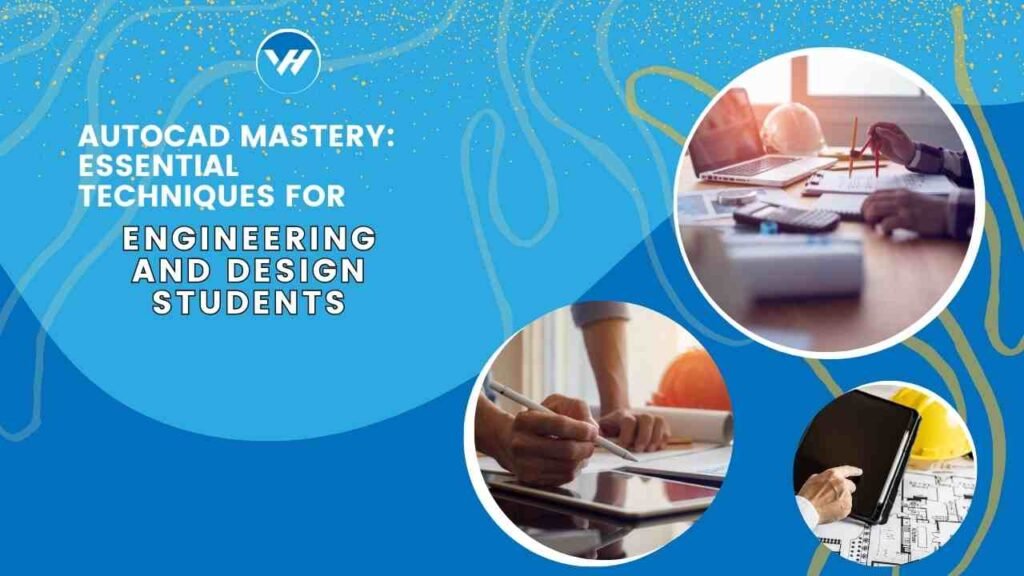AutoCAD is a powerful computer-aided design (CAD) software developed by Autodesk. It allows users to create detailed 2D and 3D designs with precision and efficiency. Whether you’re drafting architectural plans, engineering schematics, or intricate design projects, AutoCAD offers a robust set of tools to bring your ideas to life.

Table of Contents
ToggleWhy AutoCAD is Essential for Engineering and Design
For engineering and design students, mastering AutoCAD is crucial. It’s not just a tool but a standard in the industry for drafting and designing. By learning AutoCAD, students can produce professional-grade drawings, understand industry practices, and develop skills that are highly valued in the job market.
Overview of AutoCAD’s Interface
AutoCAD’s interface might seem overwhelming at first, but it’s designed to streamline your workflow. The main components include the Ribbon (where you find tools and commands), the Drawing Area (where you create and modify designs), and the Command Line (where you input commands). Familiarizing yourself with these elements will set a solid foundation for using AutoCAD effectively.
Getting Started with AutoCAD
Installing AutoCAD
Before diving into design, you’ll need to install AutoCAD on your computer. You can download the software from Autodesk’s official website. Ensure your system meets the software’s requirements for smooth performance. Installation is straightforward, but make sure to follow the prompts carefully to avoid any setup issues.
Setting Up Your First Project
Once installed, open AutoCAD and start a new project. Choose the appropriate template for your design needs, such as Architectural, Mechanical, or Custom. Setting up your project correctly from the beginning will help maintain consistency and efficiency throughout your design process.
Navigating the Workspace
Getting comfortable with AutoCAD’s workspace is key. The workspace includes various toolbars, palettes, and menus. Spend time exploring the interface and familiarize yourself with the location of essential tools. This initial step will significantly speed up your workflow and help you use AutoCAD more effectively.
Core AutoCAD Techniques
Drawing Basic Shapes
Start by mastering the creation of basic shapes. Lines, circles, and rectangles are fundamental to any design. Use the Line tool for straight lines, the Circle tool for circles, and the Rectangle tool for rectangles. Understanding these basics will help you build more complex designs later on.
Using Layers and Properties
Layers help organize your drawing elements and make it easier to manage complex projects. Use the Layer Properties Manager to create, modify, and manage layers. Adjusting object properties, such as color and line type, allows for better control and visual clarity in your designs.
Precision Drawing with Coordinates and Grid
Precision is critical in AutoCAD. Utilize coordinate systems to place objects accurately. AutoCAD supports Cartesian and Polar coordinates. Additionally, use grids and snap settings to align objects precisely and maintain consistency across your design.
Advanced Drawing Techniques
Creating Complex Shapes
Once you’re comfortable with basic shapes, move on to creating more complex ones using Polylines and Splines. Polylines allow for continuous lines with various segments, while Splines create smooth curves. Mastering these tools will enable you to handle more intricate designs.
Utilizing Advanced Commands
Advanced commands such as Offset, Mirror, and Array can significantly enhance your productivity. Offset duplicates objects at a specified distance, Mirror creates symmetrical designs, and Array duplicates objects in a pattern. These commands help in efficiently generating complex designs.
Annotation and Dimensioning
Adding annotations and dimensions is essential for creating complete and comprehensible designs. Use the Text tool to add labels and the Dimension tool to specify measurements. Multileaders and tables can further enhance the clarity and professionalism of your drawings.
Modifying and Editing Designs
Basic Editing Tools
AutoCAD provides several tools for editing designs. Trim and Extend help adjust object boundaries, while Fillet creates rounded corners. Mastering these basic editing tools allows for quick modifications and refinements to your designs.
Advanced Editing Techniques
For more complex modifications, use tools like Stretch, Scale, and Rotate. Stretch adjusts the size and shape of objects, Scale changes the overall size, and Rotate reorients objects. These techniques are essential for precise adjustments and transformations.
Managing Blocks and Attributes
Blocks are reusable design elements that can simplify complex drawings. Create blocks for frequently used components and insert them into your designs. Attributes allow for dynamic information within blocks, making it easier to update and manage data.
Customizing AutoCAD for Efficiency
Setting Up Custom Toolbars and Shortcuts
Customize AutoCAD to suit your workflow by setting up custom toolbars and keyboard shortcuts. This personalization speeds up access to frequently used tools and commands, making your work more efficient and tailored to your needs.
Creating Templates for Consistency
Templates ensure consistency across your projects. Create templates with predefined settings, layers, and styles to streamline your workflow and maintain uniformity in your designs. This practice is especially useful for collaborative projects.
Utilizing Macros and Scripts
Macros and scripts automate repetitive tasks, saving you time and effort. Learn how to create and use macros for routine actions and write scripts for more complex automation. These tools enhance your productivity and help manage large-scale projects efficiently.
Collaboration and Sharing
Working with External References (Xrefs)
External References (Xrefs) allow you to attach and manage multiple files within a single drawing. This feature is invaluable for collaborative projects, as it enables team members to work on different parts of a design simultaneously.
Sharing Files and Collaboration Tips
Sharing AutoCAD files can be done via various methods, including email, cloud storage, and direct sharing from AutoCAD. Ensure that all team members use compatible versions and follow best practices for file management and collaboration.
Using Cloud Storage for Projects
Cloud storage solutions like Autodesk’s A360 provide a platform for storing and sharing AutoCAD projects. Utilize cloud storage to access your files from anywhere, collaborate in real-time, and ensure that your projects are backed up and secure.
Troubleshooting Common Issues
Dealing with Performance Issues
If AutoCAD is running slowly, consider checking your system’s performance, updating your graphics drivers, or adjusting AutoCAD settings. Regular maintenance and updates can help resolve common performance issues.
Resolving Common Errors and Bugs
Encountering errors or bugs is not uncommon. Refer to Autodesk’s support resources or forums for solutions. Common issues include file corruption and command errors, which can usually be resolved with troubleshooting steps or updates.
Seeking Help and Resources
For additional support, explore Autodesk’s official documentation, online tutorials, and community forums. These resources provide valuable insights and solutions for overcoming challenges and enhancing your AutoCAD skills.
Conclusion
Mastering AutoCAD involves understanding its core techniques, from drawing basic shapes to using advanced commands and customizing your workspace. By applying these skills, you’ll be well-equipped to tackle various engineering and design projects with confidence.
AutoCAD mastery not only improves your design efficiency but also prepares you for professional challenges in engineering and design fields. Whether you’re creating detailed blueprints or complex 3D models, AutoCAD is a vital tool for achieving precision and excellence.
FAQs
What are the system requirements for AutoCAD?
AutoCAD requires a modern computer with a compatible operating system (Windows or macOS), a good graphics card, and sufficient RAM and storage. Check Autodesk’s website for specific requirements based on the version you are using.
How can I learn AutoCAD effectively?
Learning AutoCAD effectively involves practicing regularly, utilizing online tutorials, taking formal courses, and joining forums. Engaging with the community and experimenting with different features will also enhance your skills.
What are some common mistakes to avoid in AutoCAD?
Common mistakes include not using layers effectively, neglecting to save work frequently, and not verifying dimensions. Avoiding these mistakes ensures a smoother design process and higher-quality results.
How can Virtual Help assist with learning AutoCAD?
Virtual Help provides access to tutors and resources that can guide you through learning AutoCAD. With personalized assistance, you can get help with specific issues, improve your skills, and complete assignments effectively.
Are there any resources for advanced AutoCAD techniques?
Yes, advanced resources include specialized online courses, industry webinars, and AutoCAD’s advanced documentation. Exploring these resources can help you master sophisticated techniques and stay updated with the latest features.





